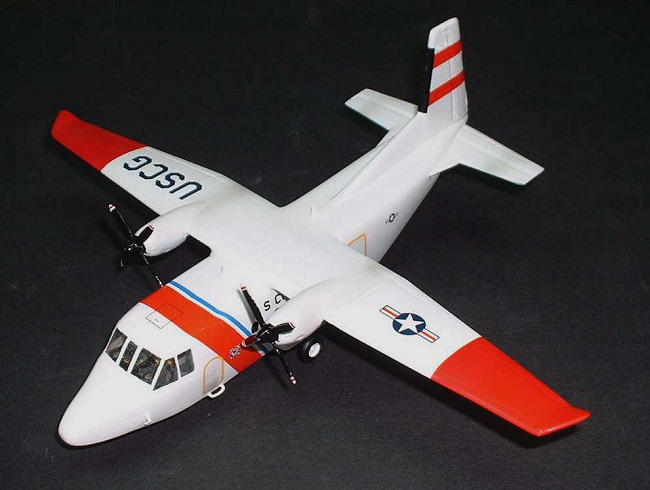
Aircraft in Miniature 1/72 CASA 212
| KIT #: | ? |
| PRICE: | $? |
| DECALS: | Six options |
| REVIEWER: | Carmel J. Attard |
| NOTES: | Vacuform plastic with etched and white metal parts |

| HISTORY |
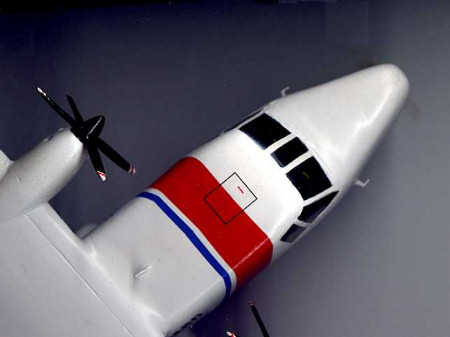 The
Aviocar CASA 212 was designed as a replacement for the Spanish Air Force ageing
fleet of Ju-52/3m(T2), the DC3 (T3) and Casa 207 AZOR (T7). It is nowadays in
common use with both the Air Force and in civilian use.
The
Aviocar CASA 212 was designed as a replacement for the Spanish Air Force ageing
fleet of Ju-52/3m(T2), the DC3 (T3) and Casa 207 AZOR (T7). It is nowadays in
common use with both the Air Force and in civilian use.
The Casa 212 is a simple unpressurised machine intended as a 16-seat passenger transport, freighter (which has a full section rear loading air-dropping door), photographic-survey aircraft, and crew ambulance and for SAR duties as well as crew trainer. Delivery began to No.461 Squadron at Gando in the Canaries as well as 403 Squadron at Cuatro Vientos, which is equipped with six photographic Aviocars. The total production today exceeds well over 100. Several Casa 212s variants are equipping several air forces around the world, which includes those of Argentina, Costa Rica, Brazil, Angola, Portugal, Zimbabwe, USCG, and Indonesia.
| THE KIT |
The kit is a multi media scale model and comes in a vacformed
sheet of black 1.5mm thick plastic. This thickness turns it into a very sturdy
model but with the drawback that the plastic sheet is less prone to take up
certain sharp corners and f ine surface detail during the manufacturing process.
Nevertheless, ‘Aircraft in Miniature Limited’, who Are producers of the kit,
thought wisely on planning this kit as enough parts are incorporated in order to
make it possible to produce any version from Series 100, 200, 300, or 400 in a
variety of colourschemes.
ine surface detail during the manufacturing process.
Nevertheless, ‘Aircraft in Miniature Limited’, who Are producers of the kit,
thought wisely on planning this kit as enough parts are incorporated in order to
make it possible to produce any version from Series 100, 200, 300, or 400 in a
variety of colourschemes.
The Casa 212 kit comes as a “Historic Wings” category and besides plastic wings, fuselage parts, tail planes, engine nacelles, wheel sponsons, and nose radome, there are also white metal parts, brass etch parts, and a clear acetate cockpit. The white metal parts are in form of several nose radome shapes, tailskids, propellers, wheels and supports, and wing tip modification parts. The brass etch parts are for finer detailed thin parts such as flap hinges, nose pitot tubes, wheel support actuators and antennae.
| CONSTRUCTION |
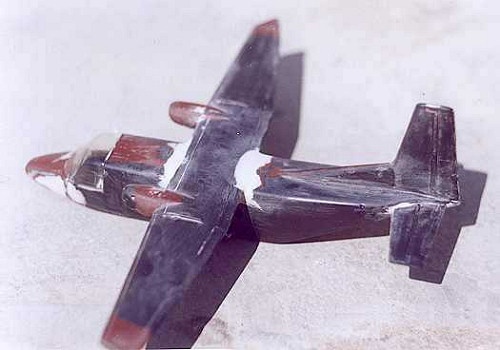 Construction is fairly straightforward but there are areas
that need a certain amount of care particularly the cockpit area, positioning
the engine nacelles where no clear indication on the kit is marked for them, and
in fitting the main undercarriage in the correct place over the fuselage. The
later may be so because the point at the mid-wing section, which is intended to
take the wings, is oversize. This means that the wing has a 3mm play so that
reference has to be made to scale plans in order to position and secure the
wings in the correct place. There are no cockpit interior parts supplied with
the kit and therefore fuselage bulkheads and floor and cockpit area needs to be
cut from the surplus plastic supplied. Also to be added are 2 to 3 crew seats,
instrument panel, and two control columns. The engine nacelles need reshaping
and the air intake at the engine front needs to be drilled open and carefully
shaped with a fine file of oval section.
Construction is fairly straightforward but there are areas
that need a certain amount of care particularly the cockpit area, positioning
the engine nacelles where no clear indication on the kit is marked for them, and
in fitting the main undercarriage in the correct place over the fuselage. The
later may be so because the point at the mid-wing section, which is intended to
take the wings, is oversize. This means that the wing has a 3mm play so that
reference has to be made to scale plans in order to position and secure the
wings in the correct place. There are no cockpit interior parts supplied with
the kit and therefore fuselage bulkheads and floor and cockpit area needs to be
cut from the surplus plastic supplied. Also to be added are 2 to 3 crew seats,
instrument panel, and two control columns. The engine nacelles need reshaping
and the air intake at the engine front needs to be drilled open and carefully
shaped with a fine file of oval section.
I have decided to produce my Casa 212 as a USCG version of the variety supplied so I have to fit the white metal wing tip extensions using super glue. A white metal nose modification, which is also supplied, was also necessary. This necessitated the removal of the plastic nose that comes moulded with the kit in order to fit the white metal longer nose as required for the USCG version. Other nose shapes are supplied to conform to the choice of CASA 212 version that one decides to do.
| COLORS & MARKINGS |
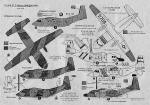 The decal sheet supplied is superb and it consists of two
different sheets of different sizes, which are packed with multi coloured
decals. These cover no less than six different variants of colour and camouflage
finishes. The longer of the two sheets has no less than 91 decal items as well
as 12 blank window decal items in case one prefers not to take tha trouble of
drilling the portholes. I did not use these as I opted to open the windows and
fill them with Kristal Kleer. The other sheet contains 40 decal items. In fact
there is enough decal data to do any CASA 212 Series 200, 300, or 400, which
come in a choice of the following schemes: A Zimbabwe AF Casa 212-200 that is
camouflaged in light earth and olive green, and again there is still a further
choice that carries a small
The decal sheet supplied is superb and it consists of two
different sheets of different sizes, which are packed with multi coloured
decals. These cover no less than six different variants of colour and camouflage
finishes. The longer of the two sheets has no less than 91 decal items as well
as 12 blank window decal items in case one prefers not to take tha trouble of
drilling the portholes. I did not use these as I opted to open the windows and
fill them with Kristal Kleer. The other sheet contains 40 decal items. In fact
there is enough decal data to do any CASA 212 Series 200, 300, or 400, which
come in a choice of the following schemes: A Zimbabwe AF Casa 212-200 that is
camouflaged in light earth and olive green, and again there is still a further
choice that carries a small 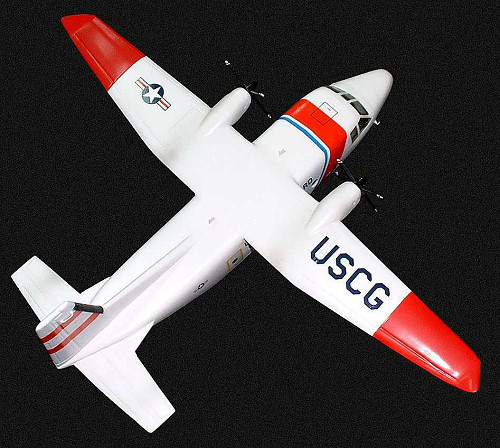 Zimbabwe bird on each side of the tail fin or
alternatively one can do the current scheme with markings consisting of roundels
in six positions, national flag on port side of wing with a large Zimbabwe bird
on the right side of the fin which carries a choice of any serial machines: 801,
802, 804, 804. Another scheme finish that comes with the kit is that of an
Angolan red and black roundel with a yellow star, normally more familiar with
Angolan Migs. The aircraft depicts also the white underside of main planes and
tail planes. This Casa 212 carries a black registration EC-137. Another option
goes for a Portuguese AF Casa 212-20-0 which is finished in light tan and dark
green camouflage and light aircraft grey underside. For some unknown reason only
the port side view is depicted and for anyone who wants to make this interesting
version would have to resort to some research books such as “ The World Air
Power Journal” in order to obtain the correct missing camouflage pattern for the
upper wings and starboard fuselage pattern.
Zimbabwe bird on each side of the tail fin or
alternatively one can do the current scheme with markings consisting of roundels
in six positions, national flag on port side of wing with a large Zimbabwe bird
on the right side of the fin which carries a choice of any serial machines: 801,
802, 804, 804. Another scheme finish that comes with the kit is that of an
Angolan red and black roundel with a yellow star, normally more familiar with
Angolan Migs. The aircraft depicts also the white underside of main planes and
tail planes. This Casa 212 carries a black registration EC-137. Another option
goes for a Portuguese AF Casa 212-20-0 which is finished in light tan and dark
green camouflage and light aircraft grey underside. For some unknown reason only
the port side view is depicted and for anyone who wants to make this interesting
version would have to resort to some research books such as “ The World Air
Power Journal” in order to obtain the correct missing camouflage pattern for the
upper wings and starboard fuselage pattern.
The more colourful and striking scheme is that of the Casa 212-300 SAR Spanish AF version. This is white overall with fluorescent orange on the underside of fuselage. This also has a black extended nose radome of round cross section. Incidentally the Spanish AF Casa are now repainted in overall grey finish and the same decals can be used with the exception of the tail fin detail C-212 036-6,which is nowadays white instead of black There is the USCG Casa 212-300, which I opted to do my model of this kit. Accompanying photos show all the decals in place for this version once the kit is given a semi-gloss overall white finish with black trim in certain places. It was a detailed scale model with enough parts in it to make a good replica of the real thing. The decal sheet was excellent but the kit would be improved if adequate 1/72 scale plans were provided with the kit.
| CONCLUSIONS |
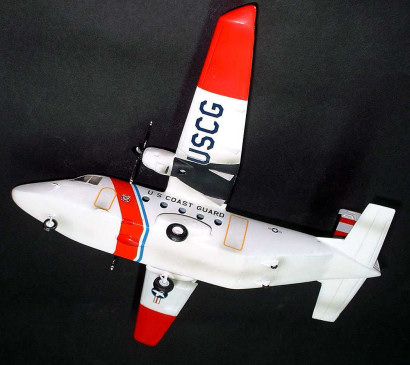 This was an interesting addition to the USCG section of my
model collection which so far consists of a C-130, a Dauphin, and a C-123
Provider and now at last, but not least, the Casa 212. From the above it is
obvious that choosing one version leaves a wide selection of surplus decal
sheet, which can be adopted for any of the following aircraft:
This was an interesting addition to the USCG section of my
model collection which so far consists of a C-130, a Dauphin, and a C-123
Provider and now at last, but not least, the Casa 212. From the above it is
obvious that choosing one version leaves a wide selection of surplus decal
sheet, which can be adopted for any of the following aircraft:
An overall light grey Shenyang 6 (Mig-21) in Zimbabwean markings. An earth and olive green camouflaged Skymaster using the small Zimbabwe Force bird on the tail fins. A white overall Talon T-38 in Portuguese AF small roundels. A three-tone camouflaged Skymaster in Portuguese AF small roundels. A PRU blue overall Mig-17 of the Angolan AF. An overall white and bright red USCG Pelican. An overall light grey Super |Puma HD21, which retains the yellow SAR bands of the Spanish AF.
May 2006
Copyright ModelingMadness.com
If you would like your product reviewed fairly and fairly quickly, please contact the editor or see other details in the Note to Contributors.